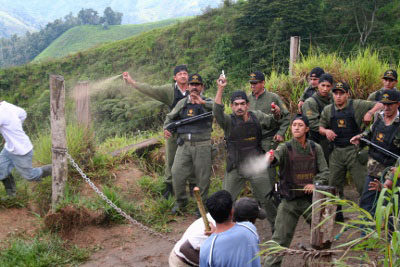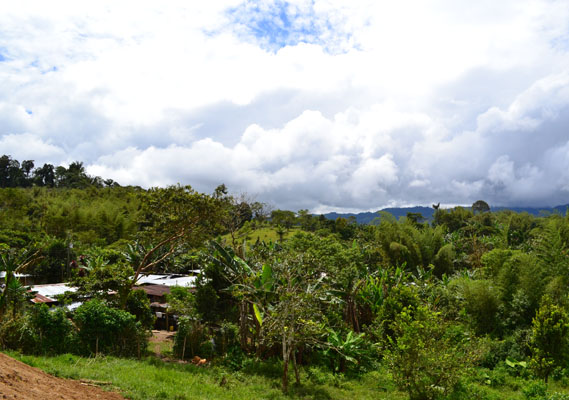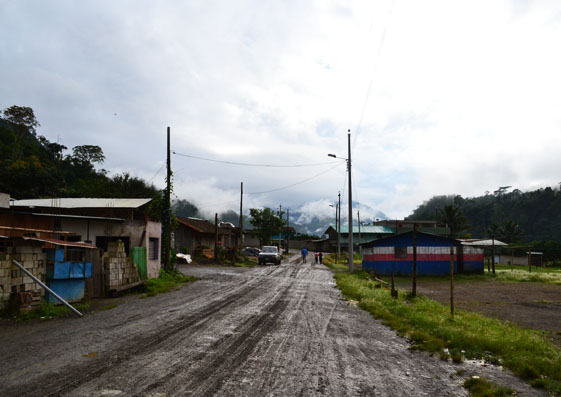
According to the government’s mining development plan, over 40% of Ecuador’s mineral wealth lies beneath the mountains and cloud forests of Ecuador’s Intag region, an area that has been an objective for multinational miners since the early 1990s. So far, those companies have been frustrated by militant anti-mining activism led by local environmentalists who believe that large-scale mining will have a catastrophic impact on the one of the world’s most biologically diverse ecosystems, cause widespread contamination of water supplies and deforestation, and put numerous endangered species at risk. “In Intag we don’t want to spoil these environmental and social riches,” said Polivio Perez, a community leader and anti-mining campaigner. “Mining is not compatible with nature.”
Campaigners also fear large-scale mining would have a devastating social impact in Intag, especially as preliminary studies foresaw the need to build a new mining town of 5,000 people. In addition to completely altering the socio-economic balance and cultural life of Intag, whose inhabitants live scattered around the region in small communities of no more than 500 residents, locals fear a spiraling crime rate and severe social problems as men from around the country flood the region looking for work. According to Silvia Quilumbango, president of environmental group Defense and Ecological Conservation of Intag (DECOIN), it is the region’s women who will be hardest hit by the changes. “Mining doesn’t generate employment for women,” she said at a public assembly. “…or if it does then what are we good for? Domestics and prostitutes, women are used for these two things.”
Building resistance, developing alternatives
The first major mining company to arrive in Intag was Japan’s Mitsubishi, and the company’s legacy remains 15 years after it left the region. A recent study commissioned by local environmental groups shows that water from the exploratory bore holes drilled by Mitsubishi in the area of Junin is still highly contaminated. The water feeds into the supply of a nearby community where, according to Marcia Ramirez, president of local women’s organization Mujeres de Junin, it has caused serious health problems. “After consuming this water contaminated with arsenic and lead it wasn’t long before people began to get stomach cancer,” she said.
Mitsubishi pulled out of Intag in 1997, following community protests that culminated with the mining company’s camp being burnt to the ground. Although the company withdrew, claiming it would return to carry out further studies, it was instead replaced by Canadian firm Ascendant Copper – now the Copper Mesa Mining Corporation. In the confrontation with the company that followed, the Intag communities faced threats, violence and legal persecution, including clashes with ex-military armed guards hired by Ascendant. However, after several years of protests, violent confrontations and court cases, Copper Mesa had its mining concessions in the region withdrawn and was forced to leave.

However, the potential of Intag’s alternatives are unlikely to be appreciated by President Correa, who has labeled opponents of his development model “romantic,” “infantile” or simply “terrorists”. According to Jose Cueva, who is director of the Intag environmental collective Corporacion Toisan, the slurs have not stopped the people of Intag contesting Correa’s concept of development. “We are against development,” he said, “development understood as an advance towards a limit that doesn’t exist. We are living in an era in which all the natural limits are already broken [and] we are starting to live in the era of absolute scarcity.”
The communities’ claims that their alternatives to development offer better economic options for the region are supported by an alternatives study for the mining project carried out by foreign academics. The study concludes that eco-tourism and sustainable agriculture will generate a “more equitable and inclusive development with advantages in generating productive and sustainable employment.” In contrast, the report asserts that mining would bring comparatively few jobs, and that after the mine closes in approximately 18 years, Intag “will suffer a severe lack of opportunities aggravated by mining’s environmental impact and deforestation.”
New battle in an old war
However, Intag’s carefully nurtured alternatives are again under threat – this time from the state-owned National Copper Corporation of Chile, CODELCO. According to Intag activists, this new mining project has been deeply flawed from the start. When CODELCO submitted the project’s Environmental Impact Assessment (EIA) to the Ecuadorian Ministry for the Environment, the ministry identified 28 instances of non-compliance with the law. Just a few months later it approved the environmental license after declaring that those issues were resolved. Campaigners say they have seen no evidence of any changes to the document, despite repeated requests for clarification from the ministry, and that the EIA remains riddled with irregularities and inaccuracies.
With the environmental license approved, CODELCO was then required to socialize the project through community consultations. According to many Intag residents, what followed was little more than a box-checking formality. “They do everything at the level of the high authorities,” said Adrian de la Cruz, who was president of Magdalena throughout the process. “They come and they say that everything is already done and the only thing you [the communities] have to do is accept it.”

Julio Espinoza from El Paraiso no longer speaks to one of his sons who works for the company after the son reported Espinoza to his bosses for going to the site to see what machinery they were using. “People have become selfish on our lands,” he said. “They don’t respect our lands; there is a terrible arrogance – that is your social impact [of mining].”
Days after CODELCO began drilling in El Paraiso, locals reported the sudden arrival of a military deployment. When questioned, the soldiers replied they were there to tackle crime, a claim widely derided by the community. “They are doing intelligence work, knowing that Intag has demonstrated a resistance to the issue of mining,” said Polivio Perez.
“This isn’t just an issue in Intag,” he added, “but on a national level. The [mining companies] want to maintain their power, they want to keep everything under control, and the only way they can do that is through the armed forces.”
A tactical retreat?
CODELCO withdrew suddenly from El Paraiso at the start of March – just as activists in Intag were planning an occupation of the exploration site, and at the same time as the anti-mining march was descending on Quito. “Maybe it was a coincidence, maybe it was politically motivated, maybe they thought with the march in progress it would be risky to be operating an illegal mining project,” said DECOIN’s Carlos Zorrilla.
The company later returned to El Paraiso to announce that they had not found sufficient deposits to justify continued mining, but said that another company may take up the concession at a later point. For the anti-mining activists however, any relief was short-lived. Around the time CODELCO was withdrawing, members of the Ecuadorian government were in Canada, putting pen to paper on the $1.4 billion deal that sparked the march on Quito. At the same time, they announced that state-owned National Mining Company of Ecuador’s (ENAMI) first project will be partnering with CODELCO in Junin.
Since the withdrawal, the Intag region has been inundated by state authorities bringing public works programs. But the sudden influx of health, road and communication projects has left activists suspicious. “There has been an unparalleled attention from the government in the Intag region,” said Zorrilla, “and I think that is part of an overall strategy to soften the opposition.”
Zorrilla believes that the withdrawal and sudden increase in social spending are also part of Correa’s strategy for the coming presidential elections, set for February of 2013. “This is part of their strategy, going in easy because they know there is a lot of well-organized resistance here, and after the election they will be in a much stronger position to come in with CODELCO,” he said. “They are just not going to provoke another flash point in Intag – they will wait until they are comfortably in power.”
With Junin designated as one of the Ecuadorian government’s ten “strategic areas” and slated for the development of mining activities this year, Zorrilla believes the El Paraiso exploration was essentially a trial run. “People are more divided about mining [in El Paraiso],” said Zorrilla. “There is a small gold mine next to Paraiso so the people are more open to mining [and] it is a new community so people are less likely to stand up for it.” He added: “My guess is they wanted to see what the opposition will do.”
While the immediate pressure has again eased for the communities of Intag, few believe that the threat has been lifted, and activist preparations continue for the next skirmishes in their war against large-scale mining. “The only thing left is to organize,” said Perez, “and I believe Intag is organized to defend our territory, defend our homes, and [the right to] ‘good living’ that is in the constitution.”
James Bargent is a freelance journalist based in Colombia. He conducted research for this Toward Freedom report in Ecuador. See jamesbargent.com
